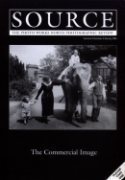Parallel Realities
Review by Paul Robinson
Issue 4 Spring 1995
View Contents ▸
Parallel Realities, published last November by Blackstaff Press with sponsorship from the IDB, ABSA, and Black Bush, has all the ingredients of a nice coffee-table book. It also has all the ingredients of a nice advertising campaign. But if we take the photographs within and mount them on a gallery wall the ingredients lack something; the resulting taste is bland and insipid, the viewer craves something more. It's a matter of context.
Introductory pages tell the reader of the book's intention. It presupposes that there are two realities at work in Northern Ireland: the reality of the Troubles, the reality flashed around the world that Northern Ireland is a war-zone peppered with sectarian murals, soldiers, and funerals; and the other reality - the beauty of Northern Ireland's scenery and the "steadfastness" of Northern Ireland's people.
This is a bogus duality bearing the hallmark of the advertiser's profession: invent a reality. The "reality" exported by the (commercially responsible) media is, in its reductionism and convenience, actually a distortion of reality: a facade. P.R.'s introduction recognises the incompleteness of the media's depiction; however, instead of renouncing this depiction as a reductionist facade and attempting to complete the picture into a well-rounded portrait, P.R. accepts the media depiction as one of two realities and sets out to portray the second "reality", the second side of what remains an ultimately two-sided coin. The "reality" we see in P.R., the nice side of Northern Ireland, is a corresponding illusion, as incomplete and reductionist as that of the media; P.R. has swallowed the media's creation of reality and in response has created its own.
In setting forth its mandate so clearly P.R.'s introduction at least provides us with an indirect disclaimer: if you want a complete portrait of Northern Ireland, showing the good and the bad, the rough and the smooth, don't look here.
What follows is 131 pages of nice pictures by six men. Jeremy Browne takes us on a journey through syrupy landscapes bleeding with sickly pigments, often unrecognisable as being Northern Ireland at all, often crying out for a line of text and a logo for red wine, smooth cigarettes, u.v. sunglasses. Where Browne aspires to the Athena poster, Geoff Smyth takes us through the yawning expanses of Calendar Art. Each of his ten photographs whispers a month. Lough Foyle shimmers with August light, Glenariff gapes open to October, a brisk March blows over Torr Head. If not a calendar then this is the stuff of Northern Ireland Tourist Board brochures. Colourful panoramic views that murmur, in Liam Neeson's sultry brogue, "Come to Northern Ireland (and don't forget your 24mm lens so you can impress the folks back home)." These are unimaginative images, oozing with commercial appeal and reaching their nadir with Smyth's presentation of the Giant's Causeway. His use of long exposure to calm the coastal waters is as stilted as it is corny.
As a contrast to the technicolor landscapes Max Forsythe and Alex McNeill concentrate on black and white portraits. The common thread of uninspired approaches to the subjects, however, continues, as does an olde worlde motif. Forsythe presents us with the Cobbler, the Horse Breeder, the Preacher, the Boat Builder, the Nun.... It's the confirmation of status quo notions of jolly old Ireland enjoyed the world over, the Honk-If-You're-Irish world of shamrock key rings and green-tinted glasses that can overlook Forsythe's often atrocious use of dodging and burning. McNeill fares slightly better in his mixture of rural and urban subjects and post A-level use of black and white, though again these pictures are imbued with conservatism in both theme and camera position. Once more, these are pictures that your ex-pat auntie would love to peruse with friends in Ontario, aghast with Well I Nevers.
These four photographers occupy a middle ground. On the one hand they generally present attractive (though far from magnetic) scenes that could be viable without any direct link to products or services. On the other hand, these images too often cannot escape the cloak of commercialism, whether by presenting Northern Ireland in the whiter-than-white, zit-free unreality of advertland, or by obediently toeing the line instituted by a commercially weaned status quo.
To this unchallengeing middle ground, the works of Colin Boyle and Paul Dawson can be seen as the two complementary perimeters. The former, in his images of the Harland and Wolff shipyard, moves furthest away from this commercialism. More than any other contributor, Boyle allows the viewer something to do; many of his images leave room for participation or interpretation, rather than simply providing easy-to-swallow baby food. In contrast, Dawson represents the purely commercial. His images appear, for the most part, to have been culled from commercial brochures and pamphlets, and the criteria by which degrees of artistry are usually judged do not apply. Elements of composition, for example, are determined not by aesthetic considerations as much as by the need to competently and effectively achieve their aim: to illustrate products, services and events clearly and unambiguously.
Dawson's work, appearing at the end of the book, reminds the foreigner - whether ex-pat or potential investor - that not only is Northern Ireland a place of beautiful landscapes and normal people, but it is also a place of modern industrial capabilities. Thus both the sentimental and the entrepreneurial can walk away satisfied - and so can the IDB. For those approaching the book with an interest in photography, however, sleep is induced, staved-off only by the occasional awakening pin-pricks of shoddy work. Finally, for those wanting a genuine portrait of the province they call Home, Parallel Realities is perhaps best approached by remembering that the use of advertising as propaganda is as old as the hills.
Other articles by Paul Robinson:
Other articles on photography from the 'Commercial' category ▸






